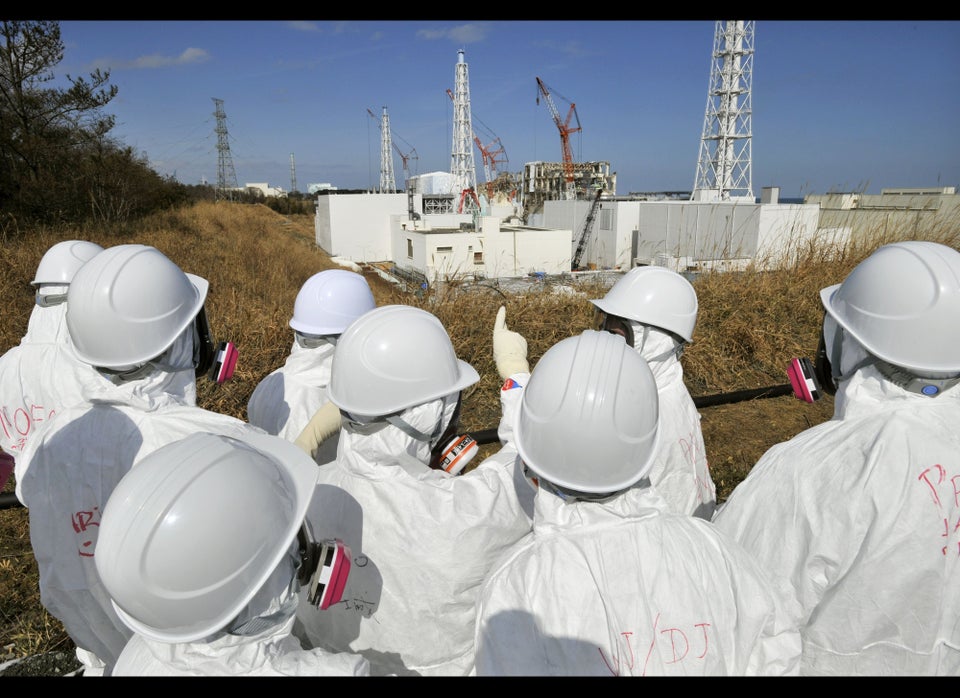
By Shinichi Saoshiro
FUKUSHIMA, Feb 28 (Reuters) - Japan's prime minister ordered workers to remain at the tsunami-crippled Fukushima nuclear plant last March as fears mounted of a "devil's chain reaction" that would force tens of millions of people to flee Tokyo, a new investigative report shows.
Then-premier Naoto Kan and his staff began referring to a worst case scenario that could threaten Japan's existence as a nation around three days after the March 11 earthquake and tsunami, according to the report by a panel set up by a private think-tank.
That was when fears mounted that thousands of spent fuel rods stored at a damaged reactor would melt and spew radiation after a hydrogen explosion at an adjacent reactor building, according to the panel report.
Yukio Edano, then Japan's top government spokesman, told the panel that at the height of tension he feared a "devil's chain reaction" in which the Fukushima Daiichi plant and the nearby Fukushima Daini facility, as well as the Tokai nuclear plant, spiralled out of control, putting the capital at risk.
Kan, who stepped down last September, came under fire for his handling of the crisis, including flying over the plant by helicopter the morning after the disasters hit -- a move some critics said contributed to a delay in the operator's response.
In an interview with Reuters this month, the 65-year-old Kan said he was haunted by the spectre of a crisis spiralling out of control and forcing the evacuation of the Tokyo greater metropolitan area, 240 km (150 miles) away and home to some 35 million people.
After the quake and tsunami struck, three reactors melted down and radiation spewed widely through eastern Japan, forcing tens of thousands of residents to evacuate from near the plant.
Plant operator Tokyo Electric Power Co, known as Tepco, managed to avert the worst scenario by pumping water, much of it from the sea, into Daiichi's damaged reactors and spent fuel pools. The reactors were stabilised by December.
A year after the disaster, however, Fukushima Daiichi still resembles a vast wasteland. High radiation levels hamper a cleanup that is expected to take decades.
The damaged 40-metre-high (125-foot) No.2 reactor building stands like a bird's nest of twisted steel beams. A Tepco official who accompanied foreign media to the plant on Tuesday said metal debris was being painstakingly removed by giant cranes and pincers as radiation doses were too high for workers.
Another challenge is keeping a new cooling system, built from a myriad of technologies and prone to breaking down, running without major glitches.
"An earthquake or tsunami like the ones seen a year ago could be a source of trouble for these (cooling) systems. But we are currently reinforcing the spent fuel pool and making the sea walls higher against tsunamis," Takeshi Takahashi, the Daiichi plant's manager, told reporters. "A series of back up systems is also being put in place in case one fails."
Confused media reports at the time of the accident said Tepco had threatened to withdraw workers from the plant, but that Kan ordered them to keep staff on-site.
"Now Tepco is saying there was no request for a complete pullout, that it only asked for a partial withdrawal. The truth may never come out, but as a result, 50 Tepco staff stayed behind and ... the worst case scenario was averted," panel chief Koichi Kitazawa told Reuters before the report's release.
STRONG SENSE OF CRISIS
How many of those who stayed were volunteers is a mystery.
"An order was likely given for full-time employees to stay behind. We may eventually find out who volunteered to stay, but the impression from our investigation is that they are under strict orders to remain silent."
The six-member panel is one of several probing the disaster caused by the quake and tsunami that knocked out cooling systems at Fukushima Daiichi and triggered meltdowns of nuclear fuel in the worst radiation crisis since Chernobyl. Since September, it has interviewed more than 300 people, including Kan and Edano, but no Tepco executives.
Kan's administration, Tepco and nuclear regulators have all faced criticism, both for a confused response and for failing to come clean on the extent of the crisis in the early days, undermining public trust in Japan's leaders and bureaucracy.
The panel lauded Kan for keeping the workers on site, but added that the premier, who had tangled with bureaucrats in the past and did not trust those around him, was too hands on in dealing with the crisis.
"Overall, he failed to pass the test," Kitazawa told a news conference after the report was issued.
Edano on Tuesday acknowledged he had feared the worst around March 14-15. "I was working with a strong sense of crisis that under various circumstances, such a thing may be possible," he told a news conference in Tokyo.
But he defended his silence as government spokesman.
"I shared all information. Back then, I was not in a position where I, as someone who is not an expert, could irresponsibly speak about my own personal impressions and my sense of crisis," he told a news conference.
"I conveyed assessments and decisions of the government, government agencies and experts," he added.
The panel report said some of Kan's seemingly inexplicable behaviour stemmed from his belief that Tepco was going to abandon the plant and the accident would spiral out of control.
An irate Kan blasted Tepco on March 15, yelling: "What the hell is going on" in an outburst overheard by a Kyodo news reporter and quickly reported around the globe. "I want you all to be determined," he was quoted as telling utility executives.
The utility ultimately left a corps of workers who were dubbed the "Fukushima Fifty" by media and won admiration at home and abroad as they risked their lives to contain the crisis, although their names were never made public. (Additional reporting by Yoko Kubota; Editing by Linda Sieg, Alex Richardson and Ron Popeski)

